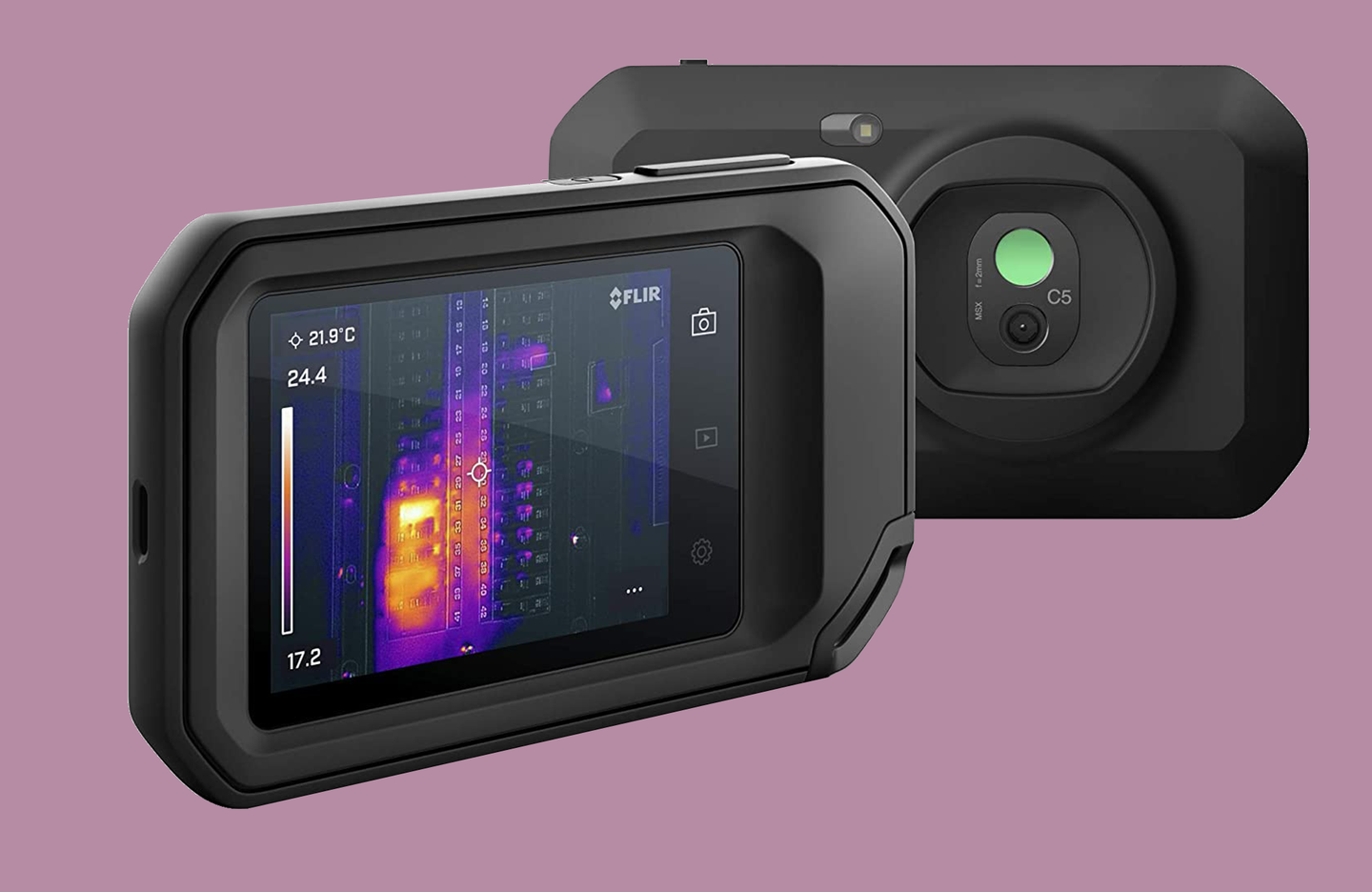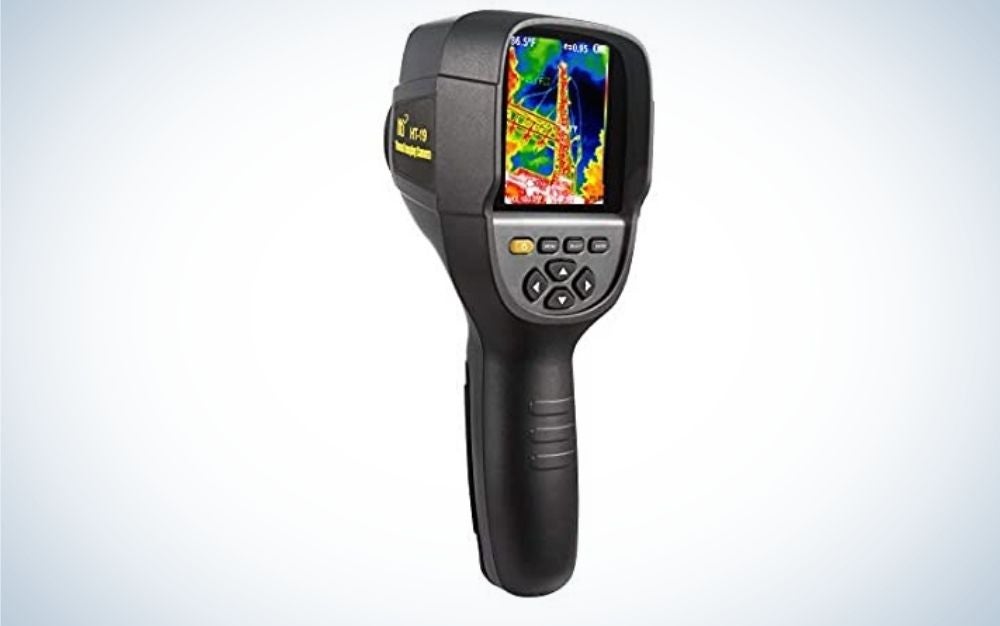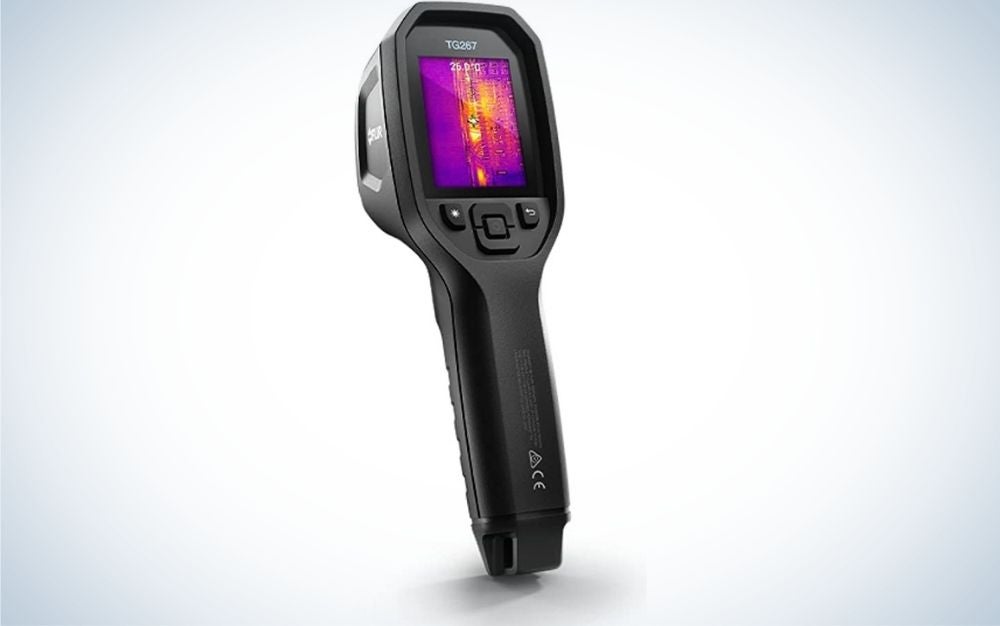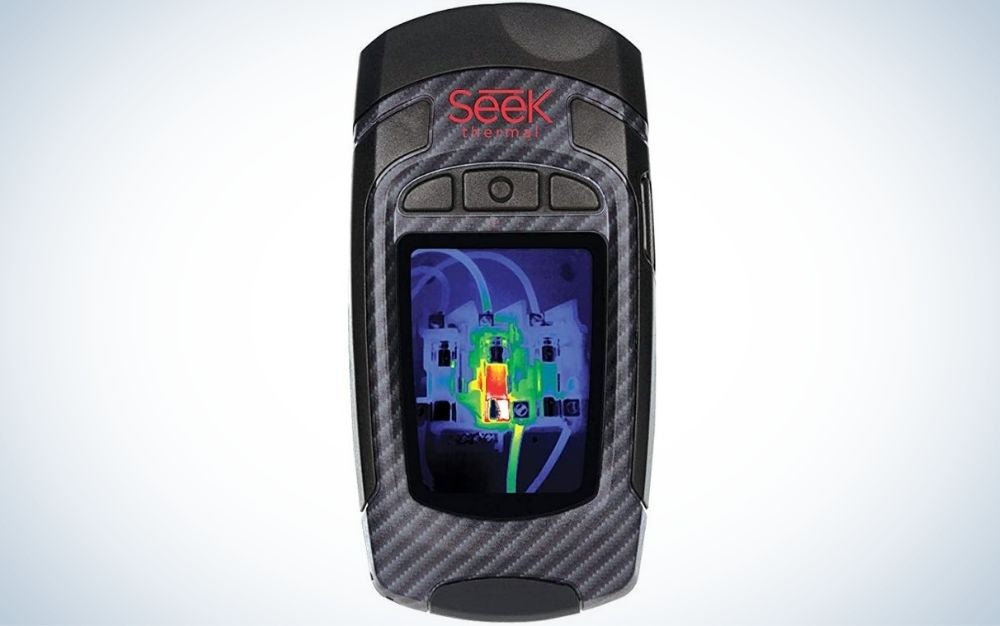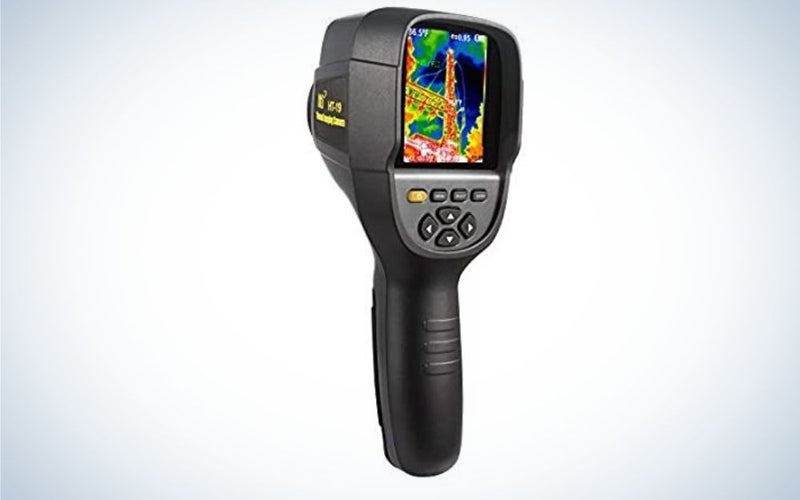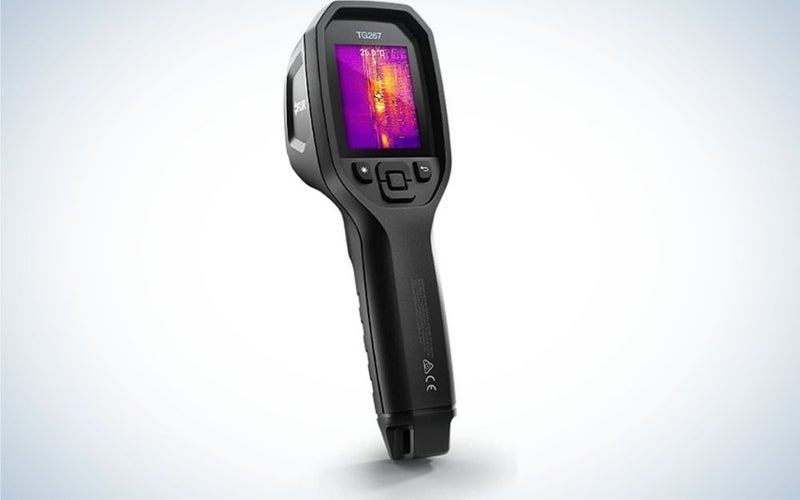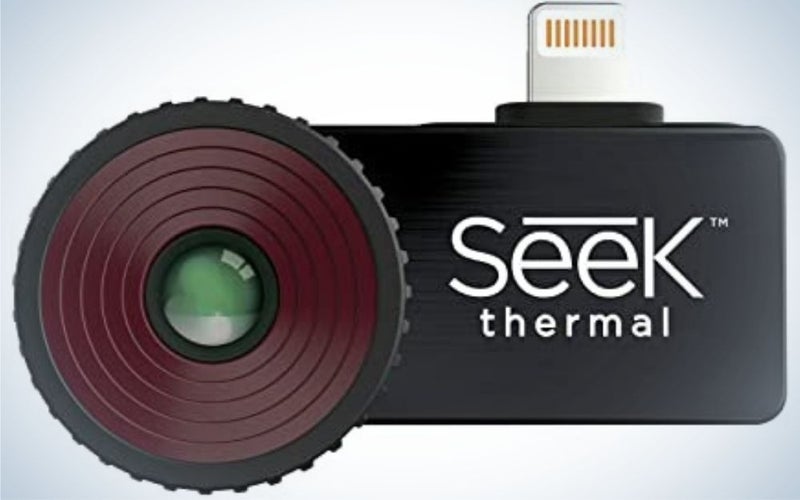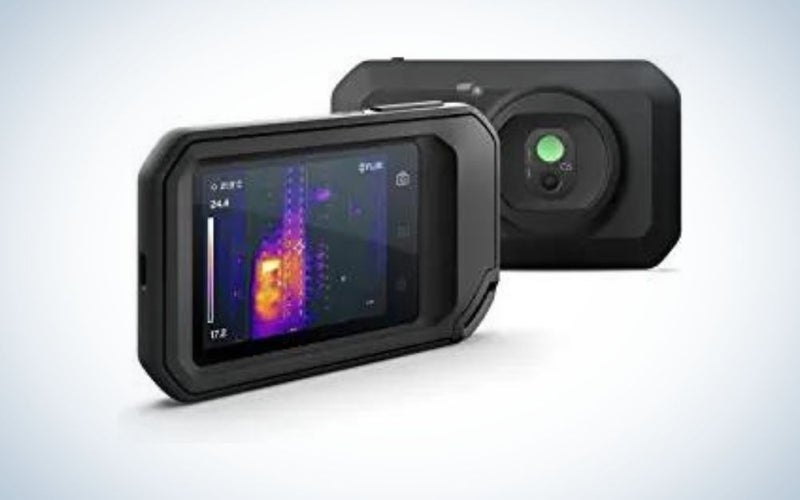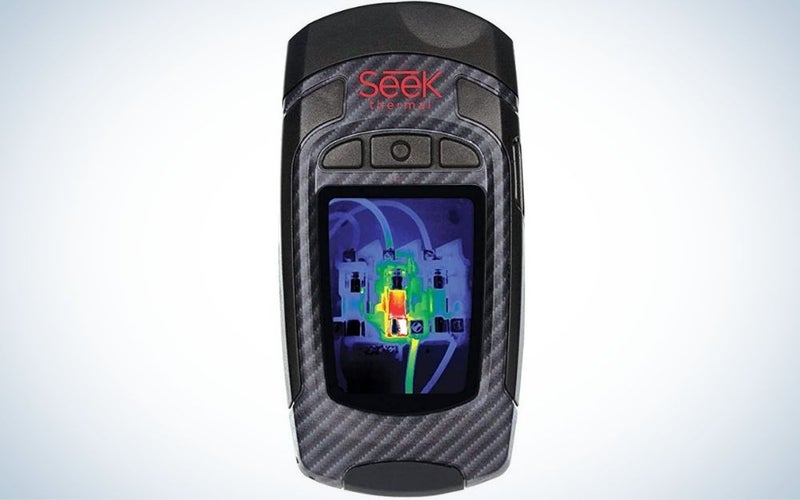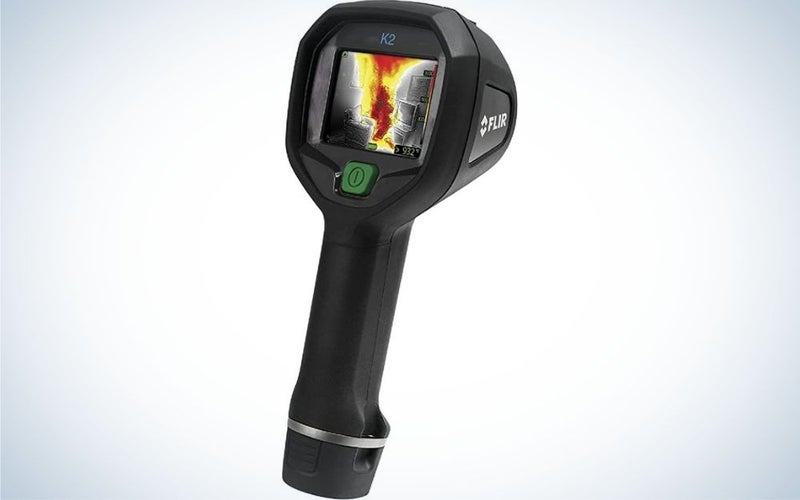We may earn revenue from the products available on this page and participate in affiliate programs. Learn more ›
Thermal imaging cameras–sometimes called heat sensor cameras or thermal imaging guns–have a broad range of applications and come in an even broader range of configurations, from thermal security cameras to specialized firefighting tools. Not every thermal imaging camera is well suited to every situation that requires one. A contractor, for example, needs a device that can identify slight variations in temperature, while a hunter might need one that has a high frame rate for tracking moving targets and can capture data from objects that are a long way away. There’s no one-size-fits-all for this specialized piece of equipment, so it pays to know each camera’s features and how they might apply to the job you need to do. Here are some of the best thermal imaging cameras out there and what you need to know to choose the one that’s right for you.
- Best overall: Hti-Xintai Higher Resolution
- Best budget: FLIR TG267
- Best for iPhone: Seek Thermal CompactPro
- Best handheld: FLIR C5
- Best for hunting: Seek Thermal RevealPRO
- Best for firefighting: FLIR K2
How we chose the best thermal imaging cameras
The best thermal imaging cameras are specialized devices most often used by professionals, so buying the wrong device can be an expensive mistake that impacts your professional reputation as well as your pocketbook. For this reason, we limited our analysis to best-selling brands with strong reputations, including FLIR, Seek, Fluke, and HTI Xintai.
Because thermal imaging devices have so many different applications, we had to consider the many different ways these devices tend to be used and what makes each one good or bad in certain situations. Of course, thermal imaging capabilities like sensitivity, accuracy, and resolution are important. But features like connectivity, battery life, and durability can also make a big difference in reliability and overall usefulness. This means we excluded devices that delivered on image quality but had other qualities that made them less practical for day-to-day use and vice-versa. We also looked for smart design features that are less critical to overall function but give a device that extra usability edge over similar devices.
The best thermal imaging cameras: Reviews & Recommendations
Best overall: Hti-Xintai HTI-19 Higher Resolution Thermal Imaging Camera
Hti-Xintai
Why it made the cut: The Hti-Xintai HTI-19 is one of the best thermal imaging cameras with a high resolution that has a large screen and is capable of capturing fine detail, making it useful for a wide range of applications.
Key features:
- Style: Pistol grip
- Resolution: 320 x 240 pixels
- Thermal sensitivity: <0.05°C (<50 mK)
Pros:
- Much higher resolution than many similar devices
- A large, easy-to-read screen
- Lightweight and comfortable to hold
Cons:
- Images can be noisy
- Cannot be tripod-mounted
The Hti-Xintai HTI-19 high resolution thermal imaging camera has an impressive 320 x 240 resolution and a lower price point, making it a good all-around thermal vision device suitable for most jobs and our best overall pick. The 3.2-inch screen is considerably larger than the screens of many similar devices, and the device also has a simple, user-friendly operation with a rechargeable battery that lasts up to three hours.
This HTI-19 is lightweight, easy to hold, and durably constructed, making it ideal for outdoor use or for environments where it might have to take some abuse, such as tight crawlspaces and construction sites. It is not tripod mountable, though, so it might not be the right device for you if you need hands-free operation.
The temperature range of this device is -4 to 932°F. This range is decent, but it won’t work well in very cold climates. The HTI-19’s thermal sensitivity is 0.05°C (<50 mK), which beats most devices in its price range, though its accuracy of ±2℃ is no better or worse than most other thermal imaging devices in this class.
The HTI-19’s 3GB of built-in memory goes a long way, but it lacks a slot for a separate memory card and doesn’t have WIFI, which may be inconvenient for users who would rather transfer images in the field. Another major drawback of this device is that it can produce noisy images, especially in the lower temperature parts of a scene.
Best budget: FLIR TG267
FLIR
Why it made the cut: Our best budget pick has a range of advanced features that make it a solid but still reasonably cheap thermal camera, whether you’re a professional or a hobbyist.
Key features:
- Style: Pistol grip
- Resolution: 160 × 120 pixels
- Thermal sensitivity: <0.07°C (<70 mK)
Pros:
- Impressive temperature range
- Bluetooth for easy in-the-field photo transfer
- Built-in laser target shows you exactly what you’re measuring
- Large capacity built-in memory
Cons:
- Lower resolution isn’t as good at capturing detail
This pistol-grip style thermal imaging gun has a couple of features our best overall pick doesn’t have, despite the lower price. It has the ability to read temperatures of -13°F (up to 716°F), a laser bullseye, and an accessory mount in case you need to put it on a tripod. The laser bullseye is an especially useful feature that helps make sure you know exactly what part of the scene you’re getting the reading from. This device has Bluetooth for easy file transfer, but if you prefer to keep the images on your device until you’re back in the office, it also has 4GB of built-in memory that holds up to 50,000 images.
Another plus for the FLIR TG267 is a rechargeable battery that lasts up to 5 hours (as long as you keep the screen at medium brightness). If you are a heavy user of the laser target, that knocks another half hour or so off your battery life, but that’s still quite good for a single charge. The FLIR TG267 has a tough build (specs claim it can survive a drop of up to 6.5 feet), so it’s a good pick if you plan to spend a lot of time with it outdoors. In average temperature conditions, its accuracy is +/-2.5°C, which is pretty good for this price point.
At 0.07°C (<70 mK), this device’s thermal sensitivity is average, but the 160 x 120 resolution is quite low, and the screen is considerably smaller than our best overall pick, which makes it harder to see the fine details in each image. Still, for the price, it is a great option.
Best for iPhone: Seek Thermal CompactPRO
Seek Thermal
Why it made the cut: With a 320 x 240 resolution that rivals and even beats that of many pistol-grip models, the Seek Thermal CompactPRO is portable and just as functional as most traditional devices.
Key features:
- Style: Smartphone attachment
- Resolution: 320 x 240 pixels
- Thermal sensitivity: <0.07°C (<70 mK)
Pros:
- High resolution lets you capture fine detail
- Excellent low temperature performance
- Uses your phone’s superior screen, storage capacity, and battery
Cons:
- Narrow field of view
If the idea of carrying around a sizable thermal imaging camera is off-putting, the Seek Thermal CompactPRO is an excellent alternative, and it’s not even a compromise. Our best for iPhone pick captures fine detail as well as or better than most handheld devices. Moreover, because it borrows the screen, battery, and storage capacity from your smartphone, it holds more images, has longer battery life, and boasts a much better image display than even very expensive thermal vision devices. With a high resolution of 320 x 240, images are crisp and detailed.
This device uses your phone’s visible light camera to create a layered image that includes both visual and thermal information, though you may have to do some manual alignment to get the image to look right. Fortunately, the app is fairly easy to use, and it also lets you play around with variables like temperature scale, emissivity, and aspect ratio.
The CompactPRO’s specs are comparable to and often better than those of many standard models. It has a decent thermal sensitivity of <0.07°C (<70 mK) and an impressive total temperature range of -40F° to 626°F, which means it’s functional in almost any climate. And since this device can capture data at a distance of up to 1,800 feet, it’s great for hunting and other outdoor applications. The CompactPRO also has a fast refresh rate of >15 Hz, which allows for smooth tracking of moving objects.
The CompactPRO’s main drawback is the 32 degree field of view (FOV), which is quite narrow compared to the FOV found in most traditional pistol-grip style models.
Best handheld: FLIR C5
FLIR
Why it made the cut: Devices in this class tend to have limitations, but the FLIR C5 has several features that are equal to or better than those of many larger, pistol-grip style devices.
Key features:
- Style: Palm-size compact
- Resolution: 160 x 120 pixels
- Thermal sensitivity: <0.07°C (<70 mK)
Pros:
- Compact format doesn’t sacrifice screen size
- Built-in cloud connectivity
- Ruggged build
- Fast charging battery
Cons:
- Low resolution
- Poor accuracy compared to other models
This compact device is our pick for best handheld device, a happy medium between the much larger, pistol-grip style cameras and the easy-to-lose phone attachments. This device is about the size of a cell phone (5.4 × 3.3 × 0.94 in) but functions as a stand-alone unit. Like your cell phone, it has a touch screen, making it almost as convenient to use. It has a few other features that are useful outdoors, too, like drop and water resistance and a built-in LED flashlight. It also has a built-in 5 megapixel visible light camera and can produce thermal images, standard images, or a combination of both.
The FLIR C5 has a few features you won’t find in many larger devices, such as built-in cloud connectivity that allows you to upload images on the fly, provided you are in a WIFI accessible area. While this is a great feature for contractors and home inspectors, it’s not very useful if you’re hunting or fighting a wildfire. Photos can also be transferred via Bluetooth and USB, however, so there are at least a few different options for getting your images off the device.
The C5 has a decent temperature range of -4 to 752°F and a fairly typical thermal sensitivity of <0.07°C (<70 mK). Where it falls behind other devices is on resolution. It’s a pricey unit,yet the resolution is comparable to our best budget pick, so most of what you’re paying for is portability and a few bells and whistles. The C5’s accuracy isn’t great, either; at ±3°C, it lags behind most other units in its price range.
Best for hunting: Seek Thermal RevealPRO
Seek Thermal
Why it made the cut: The high-resolution Thermal RevealPRO’s good battery life, broad temperature range, fast refresh rate, and ability to capture data at long distances make it an ideal thermal scanner for hunting.
Key features:
- Style: Palm-size compact
- Resolution: 320 x 240 pixels
- Thermal sensitivity: <0.07°C (<70 mK)
Pros:
- High resolution
- Can capture data even at long distances
- Long battery life
- Fast refresh rate
Cons:
- Small screen
- No WIFI or Bluetooth
At 5 x 2.4 x 1.2 inches, the Seek Thermal RevealPRO is smaller than most cell phones and fits easily into a jacket pocket, keeping your hands free to carry the rest of your gear. It has a high resolution 320 x 240 pixel thermal sensor, but its best quality for hunting is its ability to capture data from up to 1,800 feet away. The far range makes it ideal for spotting game. It also has a 4X continuous zoom so you’ll beable to identify those distant objects better.
Unlike many comparable units, the Thermal RevealPRO boasts a refresh rate of >15 Hz for smooth tracking of moving objects. In normal mode, the Thermal RevealPRO will run for about four hours on a single charge, making it ideal for longer outings. With a broad temperature range of -40 to 626°F, this device will work well no matter the season or location. In a pinch, you can also use it as a flashlight.
One of this device’s major drawbacks is the very small 2.4-inch screen, which makes it a lot harder to pick out fine details. And though it has a decent built-in storage capacity of 4GB, it doesn’t have WIFI or Bluetooth, so you’ll have to wait until you get home to transfer images off of the device.
Best for firefighting: FLIR K2
FLIR
Why it made the cut: The FLIR K2 was designed for firefighting, so it’s tough, easy to use even while wearing gloves, and has seven modes for firefighting, hot/cold detection, and search and rescue.
Key features:
- Style: Pistol-grip
- Resolution: 160 × 120 pixels
- Thermal sensitivity: <0.10°C (<100 mK)
Pros:
- Affordable
- Operable even in very high temperatures
- Drop and water resistant
- Good battery life
Cons:
- Low resolution
- Slow refresh rate
Firefighters need features that aren’t available even in many of the best thermal imaging cameras, and small firefighting units may not always have the funds to invest in higher-end models. The FLIR K2 delivers on most of what firefighters need but without an ultra-high price tag.
The FLIR K2 has a lot of really smart features that helped make it our best for firefighting pick. First and foremost, it is designed to withstand the challenging conditions that firefighters face. It’s water resistant, drop resistant to 6.5 feet, and will work consistently well in temperatures up to 135°F. It’s also designed to withstand short bursts of intense heat — at 500°F, it will continue to function for up to 3 minutes. Two nice additional features are the lanyard strap and carabiner that lets you carry it hands-free and the one-button operation that makes it easy to use even while wearing heavy gloves.
The K2 is versatile, with seven modes including basic mode, black and white firefighting mode, fire mode, search and rescue mode, heat detection mode, cold detection mode, and building analysis mode. It has a good battery life of up to 4 hours and charges to 90 percent in around 2.5 hours.
The low resolution of 160 x 120 is this device’s major drawback. This may become more of a handicap in smoky conditions when the built-in visible light camera isn’t able to display detailed visual information with the IR data. At 9 Hz, the refresh rate isn’t spectacular, which may be limiting in some situations. It’s also worth noting that the K2’s thermal sensitivity of <0.10°C (<100 mK) lags behind even many less-expensive thermal cameras, and its accuracy is a woeful ±4°C.
Related: Best night vision goggles
Things to consider before buying the best thermal imaging cameras
Not all of the best thermal imaging cameras will work well in every situation. The devices that are best for hunting, for example, have different features than those that are best for plumbers or home inspectors. Here are some of the most important variables you’ll want to consider when shopping for a thermal imaging camera.
Style
Thermal imaging devices can be pistol-grip handheld devices, Android and iPhone attachments, or compact pocket-sized handhelds. While the pistol-grip devices tend to have larger screens and more user-friendly operation, somemay find them too big and inconvenient to carry around. Compact devices and phone attachments are more portable but may have other disadvantages.
Resolution and visible light capture
Each pixel has its own temperature measurement, so many of the best thermal imaging cameras are the ones that have high-resolution thermal sensors. Although there are no real benefits to choosing a lower resolution camera,fine detail isn’t really necessary for some applications. In this case, a lower resolution device may be best for your budget. Most of the best thermal imaging cameras can also combine a thermal image with a visible light image to give youbetter detail. In some cameras, you can turn this feature on and off.
Thermal sensitivity and temperature range
Thermal sensitivity is also called Noise Equivalent Temperature Difference, or NETD. The lower the NETD, the more sensitive the device. Thermal sensitivity is expressed in degrees andmilli-Kelvins (mK), or thousandths of a degree. A camera that has a thermal sensitivity of 0.07°C or 70 mK, for example, can tell the difference between two points with a temperature difference of just 1/700ths of a degree.
You may need a camera with a low NETD if you need to spot small differences in temperature, like when looking for evidence of moisture. Keep temperature range in mind, too. If you often work in cold climates, for example, you’ll need a device that’s sensitive even at very low temperatures.
Battery life
While the best thermal imaging cameras tend to have good battery life, the importance of this feature varies according to application. For example, if you’re a home inspector or plumber and your jobs don’t require extended time in remote places, battery life might be less important to you than if you use your device for hunting or fighting wildfires.
FAQs
Q: How much do thermal imaging cameras cost?
A thermal imaging camera costs anywhere from $200 up to $3,000+, with most falling between $500 to $1,500. It is possible to get a great camera in a lower price range, but features like low NETD and exceptional accuracy tend to be found in the higher priced models. Although you can also get a thermal camera for under $100, these are typically very basic models that lack many of the features discussed here.
Q: How does a thermal camera work?
Thermal cameras work by detecting and measuring the heat signature of an object. The camera converts this information into a color map. Each temperature value in the map has its own color so you can see subtle changes in temperature in the displayed image.
Q: How accurate are thermal cameras?
The accuracy of a thermal camera is measured in degrees. Accuracy varies from model to model, but it’s typical for a camera to be accurate to between ±2°C and ±4°C. This is different from thermal sensitivity, which describes the camera’s ability to detect very slight temperature differences. .
Q: Do thermal cameras work in daylight?
Thermal cameras work in daylight just as well as they do at night. This is because the IR sensor detects temperature, not visible light. Many of these devices do include a visible light camera, however. In these models, the temperature data is overlaid on a visible light image to give you a more complete picture of the scene.
Final thoughts on the best thermal imaging cameras
Plumbers may not need all the same features that contractors need, so it was important for our best overall pick for the best thermal imaging cameras to have features that would work well for a broad range of applications. The HTI-19’s high resolution combined with good accuracy, thermal sensitivity, and affordable price makes it a good buy for all-around day-to-day use in most applications.
